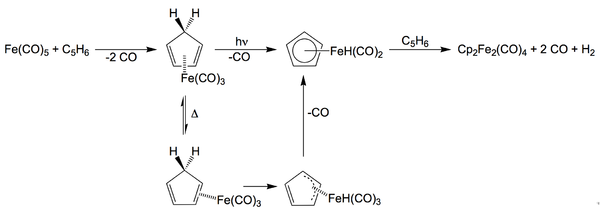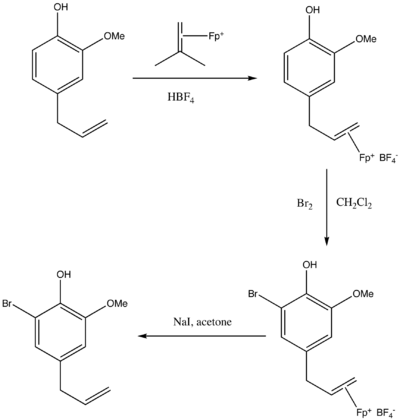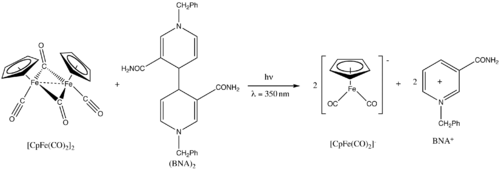- Cyclopentadienyliron dicarbonyl dimer
-
Cyclopentadienyliron dicarbonyl dimer 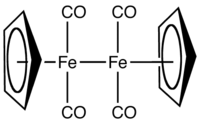
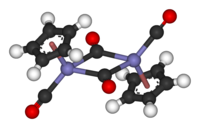 Other namesBis(cyclopentadienyl)tetracarbonyl-diiron,
Other namesBis(cyclopentadienyl)tetracarbonyl-diiron,
Di(cyclopentadienyl)tetracarbonyl-diiron,
Bis(dicarbonylcyclopentadienyliron)Identifiers CAS number 12154-95-9 
ChemSpider 24589716 
Jmol-3D images Image 1 - [C-]#[O+].[C-]#[O+].C1=CC(C=C1)[Fe+][C-]=O.C1=CC(C=C1)[Fe+][C-]=O
Properties Molecular formula C14H10Fe2O4 Molar mass 353.925 g/mol Appearance Dark purple crystals Density 1.77 g/cm3, solid Melting point 194 °C
Boiling point decomposition
Solubility in water insoluble Solubility in other solvents benzene, THF, chlorocarbons Structure Coordination
geometrydistorted octahedral Dipole moment 0 D Hazards R-phrases 20/22 S-phrases 36/37 Main hazards CO source Related compounds Related compounds Fe(C5H5)2
Fe(CO)5 dicarbonyl dimer (verify) (what is:
dicarbonyl dimer (verify) (what is:  /
/ ?)
?)
Except where noted otherwise, data are given for materials in their standard state (at 25 °C, 100 kPa)Infobox references Cyclopentadienyliron dicarbonyl dimer is an organometallic compound with the formula (C5H5)2Fe2(CO)4, also abbreviated Cp2Fe2(CO)4. It is called Fp2 or "fip dimer." It is a dark reddish-purple crystalline solid, which is readily soluble in moderately polar organic solvents such as chloroform and pyridine, but less soluble in carbon tetrachloride and carbon disulfide. Cp2Fe2(CO)4 is insoluble in but stable toward water.
Contents
Structure
In solution, Cp2Fe2(CO)4 can be considered a dimeric half sandwich complex. It exists in three isomeric forms: cis, trans, and unbridged. These isomeric forms are distinguished by the position of the ligands. Cis and trans differ in the relative position of C5H5 (Cp) ligands. And for both isomers, two CO ligands are terminal whereas the other two CO ligands bridge between the iron atoms. In the unbridged isomer, no ligands bridge between iron atoms - the metals are held together only by the Fe-Fe bond. Cis and trans isomers are the more abundant.
In solution, the three isomers interconvert. The phenomenon of rapidly interconverting structures is called fluxionality. Fluxional process for cyclopentadienyliron dicarbonyl dimer is so fast that only averaged single signal is observed in H NMR spectrum. However, the fluxional process is not fast enough for IR spectrum. Thus, three absorptions are seen for each isomer. The νco bands for bridging CO ligands are around 1780 cm-1 whereas νco bands for terminal CO ligands are about 1980 cm-1.[1]
The solid state of molecular structure of both cis and trans isomers were determined and compared by X-ray and neutron diffraction. Surprisingly, cis and trans have the same metal-metal separation, identical Fe-C bond lengths in the Fe2C2 rhomboids, an exactly planar Fe2C2 four-membered ring in the trans isomer versus a folded rhomboid in cis with an angle of 164°, and significant distortions in the Cp ring of trans isomer reflecting different Cp orbital populations.[2]
Synthesis
Cp2Fe2(CO)4 was first isolated as an intermediate in the synthesis of ferrocene from iron pentacarbonyl and dicyclopentadiene and has since been found as a byproduct of many organoiron reactions. Cp2Fe2(CO)4 is synthesized by the reaction of Fe(CO)5 and dicyclopentadiene.[1]
- 2 Fe(CO)5 + C10H12 → (C5H5)2Fe2(CO)4 + 6 CO + H2
In this preparation, dicyclopentadiene cracks to give cyclopentadiene, which reacts with Fe(CO)5. Cyclopentadiene reacts with Fe(CO)5 concomitant with loss of CO. Thereafter, the pathways differ for the photochemical and thermal routes differ subtly but both entail formation of a hydride intermediate.[2]
Applications
"Fp-"
Reductive cleavage of the Cp2Fe2(CO)4 produces derivatives formally derived from the cyclopentadienyliron dicarbonyl anion, [CpFe(CO)2]- or called Fp-. Such species are in fact covalent; there is no evidence for the existence of free Fp-. A typical reductant is sodium metal or sodium amalgam;[3] NaK alloy, and alkali metal trialkylborohydrides have been used. CpFe(CO)2]Na is a widely studied reagent since it is readily alkylated, acylated, or metalated by treatment with an appropriate electrophile.
- [CpFe(CO)2]2 + Na/Hg → 2 CpFe(CO)2Na
- [CpFe(CO)2]2 + 2 KBH(C2H5)3 → 2 CpFe(CO)2K + H2 + 2 B(C2H5)3
Treatment of NaFp with an alkyl halide (RX, X = Br, I) produces FeR(C5H5)(CO)2
- CpFe(CO)2K + CH3I → CpFe(CO)2CH3 + KI
FpBr
Bromine oxidatively cleaves the Fe-Fe bond in Fp2 to give FpBr, CpFe(CO)2Br.
- [CpFe(CO)2]2 + Br2 → 2 CpFe(CO)2Br
CpFe(CO)2Br reacts with alkenes to afford cationic alkene-Fp complexes.[4] The reactions require the addition of a Lewis acid, such as AlBr3.
Fp(alkene)+
Salts of [Fp(isobutene)]+ are widely employed for the preparation of Fp-alkene complexes by alkene exchange. The exchange process is facilitated by the loss of gaseous isobutene.
Alkene-Fp complexes can also be prepared from Fp anion indirectly. Thus, hydride abstraction from Fpalkyl compounds using the triphenylmethyl cation affords [Fp(isobutene)]+ complexes.
Reaction of NaFp with an epoxide followed by acid-promoted dehydration also affords such alkene complexes.
[CpFe(CO)2]- or Fp anion is a good alkene protecting group. Fp(alkene)+ are stable with respect to bromination, hydrogenation, and acetoxymercuration, but the alkene is easily released with sodium iodide in acetone or by warming with acetonitrile.[4]
However, the coordinated alkene is strongly activated toward nucleophile addition, leading to number of carbon-carbon bond formation. Many nucleophile addition show regioselectivity, usually occurring at the more substituted carbon. This is due to the greater positive charge density at this position. However, the regiocontrol is not always good enough to be considered in the organic synthesis. The addition of the nucleophile is completely stereoselective, anti to the Fp group.
Fp-based cyclopropanation reagents
Fp-based reagents are useful for cyclopropanations.[5] The key reagent is prepared from FpNa and has a good shelf-life, in contrast to typical Simmons-Smith intermediates and diazoalkanes.
- CpFe(CO)2Na + ClCH2SCH3 → CpFe(CO)2CH2SCH3 + NaCl
- CpFe(CO)2CH2SCH3 + CH3I + NaBF4 → [CpFe(CO)2CH2S(CH3)2]BF4 + NaI
One advantage of [FpCH2S(CH3)2]BF4 is that its use does not require specialized conditions.
- CpFe(CO)2(CH2S+(CH3)2) BF4- + (Ph)2C=CH2 → 1,1-diphenylcyclopropane
Ferric chloride is added to destroy any byproduct.
Other specialized reactions
Under photochemical conditions, Fp2 reduces the C-C bond in 1-benzyl-1,4-dihydronicotinamide dimer, (BNA)2.[6]
- [CpFe(CO)2]2 + (BNA)2 + hv(λ=350nm) → 2[CpFe(CO)2]- + 2BNA+
References
- ^ a b Girolami, G.; Rauchfuss, T.; Angelici, R. (1999). Synthesis and Technique in Inorganic Chemistry (3rd ed.). Sausalito: University Science Books. pp. 171–180. ISBN 978-0-935702-48-4.
- ^ a b Sir Geoffrey Wilkinson (ed.) (1982). Comprehensive Organometallic Chemistry, Volume 4. New York: Pergamon Press. pp. 513–613. ISBN 978-0-08-025269-8.
- ^ Tony C. T. Chang, Myron Rosenblum, and Nancy Simms (1993), "Vinylation of Enolates with a Vinyl Cation Equivalent", Org. Synth., http://www.orgsyn.org/orgsyn/orgsyn/prepContent.asp?prep=cv8p0479; Coll. Vol. 8: 479
- ^ a b Pearson, A. J. (1994). Iron Compounds in Organic Synthesis. San Diego: Academic Press. pp. 22–35. ISBN 978-0-12-548270-7.
- ^ M. N. Mattson, E. J. O'Connor, P. Helquist “Cyclopropanation Using an Iron-Containing Methylene Transfer Reagent: 1,1-Diphenylcyclopropane” Organic Syntheses Collective Volume 9, page 372.
- ^ S. Fukuzumi, K. Ohkubo, M. Fujitsuka, O. Ito, M. C. Teichmann, E. Maisonhaute and C. Amatore (2001). "Photochemical Generation of Cyclopentadienyliron Dicarbonyl Anion by a Nicotinamide Adenine Dinucleotide Dimer Analogue". Inorg. Chem. 40 (6): 1213–1219. doi:10.1021/ic0009627.
Categories:- Organoiron compounds
- Coordination compounds
- Carbonyl complexes
- Cyclopentadienyl complexes
Wikimedia Foundation. 2010.

